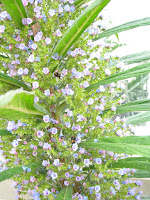 isn't right especially since she "appreciates my sense of humor". Many people, including Mrs. Phactor, think this sort of encouragement is unwise. Nonsense!
isn't right especially since she "appreciates my sense of humor". Many people, including Mrs. Phactor, think this sort of encouragement is unwise. Nonsense! 
When the images Cindy supplied were examined, a feeling of deja vu came over me, again. And sure enough a quick search of the photo archives confirmed that a closely related plant had caught my attention on a botanical geek tour two years ago, and it remained an unknown. My fans will be glad to know that having recognized the family almost immediately, my second guess as to
 their identity proved correct. Cindy said her plant seemed to grow wild
their identity proved correct. Cindy said her plant seemed to grow wild  around San Francisco, but it has escaped from cultivation and has weedy proclivities (in fact it's a pest down under). It is a long way from home in the Madeira Islands. My plant was being cultivated at the Kew Gardens. Both can grow to 2 meters tall.
around San Francisco, but it has escaped from cultivation and has weedy proclivities (in fact it's a pest down under). It is a long way from home in the Madeira Islands. My plant was being cultivated at the Kew Gardens. Both can grow to 2 meters tall.So let's see how you do. Can you get the family? How about the two species?
















7 comments:
Genus Echium of the Boraginaceae? I would have to cheat and actually look it up to find out which species. Is there an E. maderensis?
A gold star for Pat! These are both species of Echium in the Boraginaceae. Cindy's plant, the prettier one, is E. candicans, and mine, the taller one, is E. pininana.
I might have mentioned spending some time in the South of Spain. With the help of Polunin's book I found four species of Echium in one ruined sea fort outside Cadiz. Little ones like we have in the UK, though, not giant exotic ones. I have always loved that name - Viper's Bugloss.
Viper's bugloss - an interesting common name that had completely slipped my mind; thanks for adding that for Cindy and everyone else. No idea how such a name originated or exactly what it means.
Bugloss comes from Ox-tongue in Greek, from the shape and roughness (and sticky mucilage?) of the leaves, perhaps. It was said to cure the bite of the Viper and scorpions. The shape of the inflorescence was said to be like that of the Viper, so God was pointing out its use.
echis ( ἔχις ) meant viper in Ancient Greek and the plant echion ( ἔχιον ) was probably an Echium.
Obviously Ruskin preferred the pallid Myosotis, according to this quote from the OED:
1869 RUSKIN Q. of Air §87 It [the serpent spirit] enters into the forget-me-not, and the star of heavenly turquoise is corrupted into the viper's bugloss.
Pat, thanks for the explanation of "viper's bugloss". You learn something everyday!
I know this is an old post (I've backed up and started reading from the beginning) but I love these plants. I come from South Australia, and thus live in the only state in the country where Echium plantagineum (Patterson's Curse) is considered more of an enhancement and less of a weed, due to the attractive qualities of its honey and its value as fodder for ruminants in drought years. Even so, the plant is still invasive here and is the focus of serious bio-control measures by the CSIRO. I have Echium candicans in my front garden and it is a truly spectacular plant.
Ciao, KK
Post a Comment